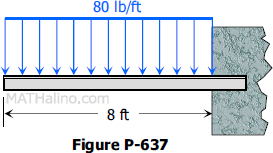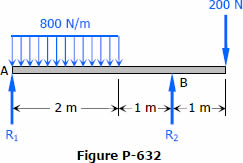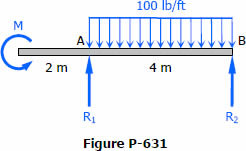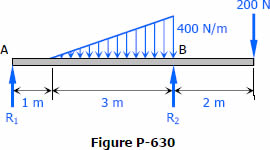Solution to Problem 638 | Deflection of Cantilever Beams
Problem 638
For the cantilever beam shown in Fig. P-638, determine the value of EIδ at the left end. Is this deflection upward or downward?

 MATHalinoEngineering Math Review
MATHalinoEngineering Math ReviewProblem 638
For the cantilever beam shown in Fig. P-638, determine the value of EIδ at the left end. Is this deflection upward or downward?

Problem 637
For the beam loaded as shown in Fig. P-637, determine the deflection 6 ft from the wall. Use E = 1.5 × 106 psi and I = 40 in4.

A quadrilateral is said to be cyclic if its vertices all lie on a circle. In cyclic quadrilateral, the sum of two opposite angles is 180° (or π radian); in other words, the two opposite angles are supplementary.
$B + D = 180^\circ$

Quadrilateral is a polygon of four sides and four vertices. It is also called tetragon and quadrangle. In the triangle, the sum of the interior angles is 180°; for quadrilaterals the sum of the interior angles is always equal to 360°
Classifications of Quadrilaterals
There are two broad classifications of quadrilaterals; simple and complex. The sides of simple quadrilaterals do not cross each other while two sides of complex quadrilaterals cross each other.
Simple quadrilaterals are further classified into two: convex and concave. Convex if none of the sides pass through the quadrilateral when prolonged while concave if the prolongation of any one side will pass inside the quadrilateral.
Problem 636
The cantilever beam shown in Fig. P-636 has a rectangular cross-section 50 mm wide by h mm high. Find the height h if the maximum deflection is not to exceed 10 mm. Use E = 10 GPa.

Generally, the tangential deviation t is not equal to the beam deflection. In cantilever beams, however, the tangent drawn to the elastic curve at the wall is horizontal and coincidence therefore with the neutral axis of the beam. The tangential deviation in this case is equal to the deflection of the beam as shown below.
Problem 632
For the beam loaded as shown in Fig. P-632, compute the value of (AreaAB) barred(X)A. From this result, is the tangent drawn to the elastic curve at B directed up or down to the right? (Hint: Refer to the deviation equations and rules of sign.)

Problem 631
Determine the value of the couple M for the beam loaded as shown in Fig. P-631 so that the moment of area about A of the M diagram between A and B will be zero. What is the physical significance of this result?

Problem 630
For the beam loaded as shown in Fig. P-630, compute the value of (AreaAB)barred(X)A . From the result determine whether the tangent drawn to the elastic curve at B slopes up or down to the right. (Hint: Refer to the deviation equations and rules of sign.)

Problem 629
Solve Prob. 628 if the sense of the couple is counterclockwise instead of clockwise as shown in Fig. P-628.

Recent comments
(…